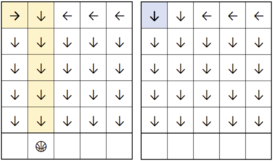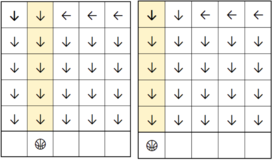Mr. Chanek has a new game called Dropping Balls. Initially, Mr. Chanek has a grid $$$a$$$ of size $$$n \times m$$$
Each cell $$$(x,y)$$$ contains an integer $$$a_{x,y}$$$ denoting the direction of how the ball will move.
- $$$a_{x,y}=1$$$ — the ball will move to the right (the next cell is $$$(x, y + 1)$$$);
- $$$a_{x,y}=2$$$ — the ball will move to the bottom (the next cell is $$$(x + 1, y)$$$);
- $$$a_{x,y}=3$$$ — the ball will move to the left (the next cell is $$$(x, y - 1)$$$).
Every time a ball leaves a cell $$$(x,y)$$$, the integer $$$a_{x,y}$$$ will change to $$$2$$$. Mr. Chanek will drop $$$k$$$ balls sequentially, each starting from the first row, and on the $$$c_1, c_2, \dots, c_k$$$-th ($$$1 \leq c_i \leq m$$$) columns.
Determine in which column each ball will end up in (position of the ball after leaving the grid).
The first line contains three integers $$$n$$$, $$$m$$$, and $$$k$$$ ($$$1 \leq n, m \leq 1000$$$, $$$1 \leq k \leq 10^5$$$) — the size of the grid and the number of balls dropped by Mr. Chanek.
The $$$i$$$-th of the next $$$n$$$ lines contains $$$m$$$ integers $$$a_{i,1},a_{i,2},\ldots,a_{i,m}$$$ ($$$1 \leq a_{i,j} \leq 3$$$). It will satisfy $$$a_{i, 1} \ne 3$$$ and $$$a_{i, m} \ne 1$$$.
The next line contains $$$k$$$ integers $$$c_1, c_2, \ldots, c_k$$$ ($$$1 \leq c_i \leq m$$$) — the balls' column positions dropped by Mr. Chanek sequentially.
Output $$$k$$$ integers — the $$$i$$$-th integer denoting the column where the $$$i$$$-th ball will end.
5 5 3 1 2 3 3 3 2 2 2 2 2 2 2 2 2 2 2 2 2 2 2 2 2 2 2 2 1 2 1
2 2 1
1 2 2 1 3 1 2
1 2
In the first example, the first ball will drop as follows. Note that the cell $$$(1, 1)$$$ will change direction to the bottom direction.

The second and third balls will drop as follows.

All balls will be dropped from the first row and on the $$$c_1, c_2, \dots, c_k$$$-th columns respectively. A ball will stop dropping once it leaves the grid.
| Название |
|---|




